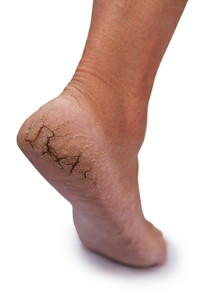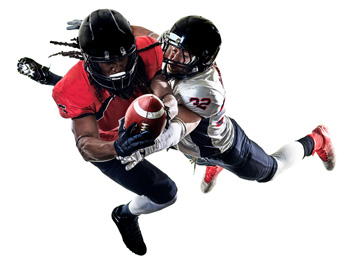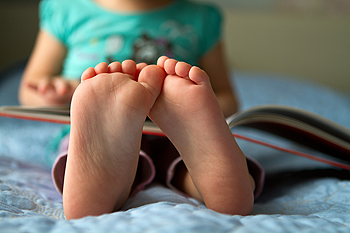Connect With Us
Blog
Items filtered by date: January 2018
What Treatment Options Are Available for Cracked Heels?
 One of the most common causes of cracked heels is a lack of moisture. Typically, a callus will begin to form, and when coupled with dryness the skin can split. This is often accompanied by pain and bleeding. Other medical causes may include thyroid disease, diabetes, and vitamin deficiency, in addition to possibly wearing incorrect shoes. Calluses can form from having dropped arches, affecting the heel as walking occurs, which may put additional stress on the foot. These conditions can cause the skin to become less supple and can incur diminished flexibility while walking, therefore leading to cracks in the skin. Treatments may include practicing improved nutrition and applying moisturizers. The skin on the heel will possibly feel more comfortable when the hardened calluses are removed. A consultation with a podiatrist may be considered for treatment options if cracked heels are affecting your day to day activities.
One of the most common causes of cracked heels is a lack of moisture. Typically, a callus will begin to form, and when coupled with dryness the skin can split. This is often accompanied by pain and bleeding. Other medical causes may include thyroid disease, diabetes, and vitamin deficiency, in addition to possibly wearing incorrect shoes. Calluses can form from having dropped arches, affecting the heel as walking occurs, which may put additional stress on the foot. These conditions can cause the skin to become less supple and can incur diminished flexibility while walking, therefore leading to cracks in the skin. Treatments may include practicing improved nutrition and applying moisturizers. The skin on the heel will possibly feel more comfortable when the hardened calluses are removed. A consultation with a podiatrist may be considered for treatment options if cracked heels are affecting your day to day activities.
Cracked heels are unsightly and can cause further damage to your shoes and feet. If you have any concerns, contact one of our podiatrists from Family Foot and Ankle Care of Moriches. Our doctors can provide the care you need to keep you pain-free and on your feet.
Cracked Heels
Cracked heels appear unappealing and can make it harder for you walk around in sandals. Aside from looking unpleasant, cracked heels can also tear stockings, socks, and wear out your shoes. There are several methods to help restore a cracked heel and prevent further damage.
How Do You Get Them?
Dry skin is the number one culprit in creating cracked heels. Many athletes, walkers, joggers, and even swimmers suffer from cracked heels. Age and skin oil production play a role to getting cracked heels as well.
Promote Healing
Over the counter medicines can help, especially for those that need instant relief or who suffer from chronic dry feet.
Wear Socks – Wearing socks with medicated creams helps lock in moisture.
Moisturizers – Applying both day and night will help alleviate dryness which causes cracking.
Pumice Stones – These exfoliate and remove dead skin, which allows for smoother moisturizer application and better absorption into the skin.
Change in Diet
Eating healthy with a well-balanced diet will give the skin a fresh and radiant look. Your body responds to the kinds of food you ingest. Omega-3 fatty acids and zinc supplements can also revitalize skin tissue.
Most importantly, seek professional help if unsure how to proceed in treating cracked heels. A podiatrist will help you with any questions or information needed.
If you have any questions, please feel free to contact our offices located in Moriches and Shirley, NY . We offer the newest diagnostic and treatment technologies for all your foot care needs.
Signs I May Have Toenail Fungus
 Occasionally, toenail fungus may come from inherited genes, although this condition may originate from several different sources. It’s caused by a fungus that multiplies, possibly initiating a toenail infection. The technical name for this fungus is onychomycosis, and yeast is the fungus that affects the skin. Symptoms of having a toenail fungus include the nail becoming brittle and yellow and the shape of the nail changing. If the immune system is compromised, it may become a serious infection that spreads beyond the toes. Toenail infections are common in diabetic patients, in addition to circulation issues and nerve complications. Another type of a fungal infection affecting the toes is called fungal paronychia, often leading to redness and swelling. If you feel you have any of these conditions, please consult a podiatrist for a foot examination.
Occasionally, toenail fungus may come from inherited genes, although this condition may originate from several different sources. It’s caused by a fungus that multiplies, possibly initiating a toenail infection. The technical name for this fungus is onychomycosis, and yeast is the fungus that affects the skin. Symptoms of having a toenail fungus include the nail becoming brittle and yellow and the shape of the nail changing. If the immune system is compromised, it may become a serious infection that spreads beyond the toes. Toenail infections are common in diabetic patients, in addition to circulation issues and nerve complications. Another type of a fungal infection affecting the toes is called fungal paronychia, often leading to redness and swelling. If you feel you have any of these conditions, please consult a podiatrist for a foot examination.
For more information about treatment, contact one of our podiatrists of Family Foot and Ankle Care of Moriches. Our doctors can provide the care you need to keep you pain-free and on your feet.
Toenail Fungus Treatment
Toenail fungus is a condition that affects many people and can be especially hard to get rid of. Fortunately, there are several methods to go about treating and avoiding it.
Antifungals & Deterrence
Oral antifungal medicine has been shown to be effective in many cases. It is important to consult with a podiatrist to determine the proper regiment for you, or potentially explore other options.
Applying foot powder on the feet and shoes helps keep the feet free of moisture and sweat.
Sandals or open toed shoes – Wearing these will allow air movement and help keep feet dry. They also expose your feet to light, which fungus cannot tolerate. Socks with moisture wicking material also help as well.
If you have any questions please feel free to contact our offices located in Moriches and Shirley, NY . We offer the newest diagnostic tools and technology to treat your foot and ankle needs.
Does My Baby Have an Ingrown Toenail?
When a toe is affected by the nail pressing into the skin, this condition is referred to as an ingrown toenail. This condition affects not only grown adults, but children and babies as well. Your baby may cry when the big toe rubs against a shoe or sock, and the tender skin will often be painful. A blister may emerge, and if an infection occurs, the discharge will be yellowish in color if it breaks. To prevent this condition, it’s recommended to use a nail clipper instead of scissors, which allows the nail to be cut straight across. Babies' feet typically grow fast, so it’s crucial to check the fit of the shoes and socks often. A consultation with a podiatrist may be advised for treatment options, which may include administering an antibiotic and possibly trimming the nail away from the skin.
Ingrown toenails can become painful if they are not treated properly. For more information about ingrown toenails, contact one of our podiatrists of Family Foot and Ankle Care of Moriches. Our doctors can provide the care you need to keep you pain-free and on your feet.
Ingrown Toenails
Ingrown toenails occur when a toenail grows sideways into the bed of the nail, causing pain, swelling, and possibly infection.
Causes
- Bacterial infections
- Improper nail cutting such as cutting it too short or not straight across
- Trauma to the toe, such as stubbing, which causes the nail to grow back irregularly
- Ill-fitting shoes that bunch the toes too close together
- Genetic predisposition
Prevention
Because ingrown toenails are not something found outside of shoe-wearing cultures, going barefoot as often as possible will decrease the likeliness of developing ingrown toenails. Wearing proper fitting shoes and using proper cutting techniques will also help decrease your risk of developing ingrown toenails.
Treatment
Ingrown toenails are a very treatable foot condition. In minor cases, soaking the affected area in salt or antibacterial soaps will not only help with the ingrown nail itself, but also help prevent any infections from occurring. In more severe cases, surgery is an option. In either case, speaking to your podiatrist about this condition will help you get a better understanding of specific treatment options that are right for you.
If you have any questions please feel free to contact our offices located in Moriches and Shirley, NY . We offer the newest diagnostic and treatment technologies for all your foot and ankle needs.
What do Running, Jumping and Football All Have in Common?
 Most athletes at some point will sustain a foot or ankle injury which may become a chronic, ongoing condition possibly affecting different parts of the foot. Symptoms of an ankle sprain may be swelling, tenderness, and bruising in addition to experiencing intense pain. Any athlete that plays a sport that includes jumping and running may be susceptible to sprains and breaks of the ankle. It can occur as a chronic condition, possibly affecting long-distance runners, or from an incident such as falling, common among football players. Another type of injury may be shin splints, often characterized by tenderness and pain in the front of the leg. This occurs when the unconditioned leg endures repeated strain, usually happening at the beginning of a training regimen. Runners may experience sharp pains in the foot, often referred to as plantar fasciitis, as extra stress is put on the numerous bones and joints. When the band of tissue that runs across the bottom of the foot becomes inflamed, symptoms may include severe pain and difficulty in walking. A consultation with a podiatrist is advised for a diagnosis and treatment options.
Most athletes at some point will sustain a foot or ankle injury which may become a chronic, ongoing condition possibly affecting different parts of the foot. Symptoms of an ankle sprain may be swelling, tenderness, and bruising in addition to experiencing intense pain. Any athlete that plays a sport that includes jumping and running may be susceptible to sprains and breaks of the ankle. It can occur as a chronic condition, possibly affecting long-distance runners, or from an incident such as falling, common among football players. Another type of injury may be shin splints, often characterized by tenderness and pain in the front of the leg. This occurs when the unconditioned leg endures repeated strain, usually happening at the beginning of a training regimen. Runners may experience sharp pains in the foot, often referred to as plantar fasciitis, as extra stress is put on the numerous bones and joints. When the band of tissue that runs across the bottom of the foot becomes inflamed, symptoms may include severe pain and difficulty in walking. A consultation with a podiatrist is advised for a diagnosis and treatment options.
Sports related foot and ankle injuries require proper treatment before players can go back to their regular routines. For more information, contact one of our podiatrists of Family Foot and Ankle Care of Moriches. Our doctors can provide the care you need to keep you pain-free and on your feet.
Sports Related Foot and Ankle Injuries
Foot and ankle injuries are a common occurrence when it comes to athletes of any sport. While many athletes dismiss the initial aches and pains, the truth is that ignoring potential foot and ankle injuries can lead to serious problems. As athletes continue to place pressure and strain the area further, a mild injury can turn into something as serious as a rupture and may lead to a permanent disability. There are many factors that contribute to sports related foot and ankle injuries, which include failure to warm up properly, not providing support or wearing bad footwear. Common injuries and conditions athletes face, including:
- Plantar Fasciitis
- Plantar Fasciosis
- Achilles Tendinitis
- Achilles Tendon Rupture
- Ankle Sprains
Sports related injuries are commonly treated using the RICE method. This includes rest, applying ice to the injured area, compression and elevating the ankle. More serious sprains and injuries may require surgery, which could include arthroscopic and reconstructive surgery. Rehabilitation and therapy may also be required in order to get any recovering athlete to become fully functional again. Any unusual aches and pains an athlete sustains must be evaluated by a licensed, reputable medical professional.
If you have any questions please feel free to contact our offices located in Moriches and Shirley, NY . We offer the newest diagnostic and treatment technologies for all your foot and ankle needs.
Reasons for Swollen Feet During Pregnancy
 Additional fluid developing in the body due to pregnancy is often the cause of swollen feet and ankles. Although it’s generally not harmful, it is typically uncomfortable, especially during warmer weather. There are several ways to ease the swelling, which may include wearing shoes that are comfortable, resting, elevating the feet, and doing your best to eliminate long periods of standing. Performing foot exercises may also be beneficial in reducing swelling and preventing cramps. Some of these may include pointing, flexing, and rotating your foot several times, thus promoting improved circulation. Occasionally, swelling in the feet may be a symptom of more serious conditions. If you have swelling in your feet, make sure to see a doctor.
Additional fluid developing in the body due to pregnancy is often the cause of swollen feet and ankles. Although it’s generally not harmful, it is typically uncomfortable, especially during warmer weather. There are several ways to ease the swelling, which may include wearing shoes that are comfortable, resting, elevating the feet, and doing your best to eliminate long periods of standing. Performing foot exercises may also be beneficial in reducing swelling and preventing cramps. Some of these may include pointing, flexing, and rotating your foot several times, thus promoting improved circulation. Occasionally, swelling in the feet may be a symptom of more serious conditions. If you have swelling in your feet, make sure to see a doctor.
Pregnant women with swollen feet can be treated with a variety of different methods that are readily available. For more information about other cures for swollen feet during pregnancy, consult with one of our podiatrists from Family Foot and Ankle Care of Moriches. Our doctors will attend to all of your foot and ankle needs.
What Foot Problems Can Arise During Pregnancy?
One problem that can occur is overpronation, which occurs when the arch of the foot flattens and tends to roll inward. This can cause pain and discomfort in your heels while you’re walking or even just standing up, trying to support your baby.
Another problem is edema, or swelling in the extremities. This often affects the feet during pregnancy but tends to occur in the later stages.
How Can I Keep My Feet Healthy During Pregnancy?
- Wearing orthotics can provide extra support for the feet and help distribute weight evenly
- Minimize the amount of time spent walking barefoot
- Wear shoes with good arch support
- Wear shoes that allow for good circulation to the feet
- Elevate feet if you experience swelling
- Massage your feet
- Get regular, light exercise, such as walking, to promote blood circulation to the feet
If you have any questions please feel free to contact our offices located in Moriches and Shirley, NY . We offer the newest diagnostic and treatment technologies for all your foot and ankle needs.
Blog Archives
- March 2025
- February 2025
- January 2025
- December 2024
- November 2024
- October 2024
- September 2024
- August 2024
- July 2024
- June 2024
- May 2024
- April 2024
- March 2024
- February 2024
- January 2024
- December 2023
- November 2023
- October 2023
- September 2023
- August 2023
- July 2023
- June 2023
- May 2023
- April 2023
- March 2023
- February 2023
- January 2023
- December 2022
- November 2022
- October 2022
- September 2022
- August 2022
- July 2022
- June 2022
- May 2022
- April 2022
- March 2022
- February 2022
- January 2022
- December 2021
- November 2021
- October 2021
- September 2021
- August 2021
- July 2021
- June 2021
- May 2021
- April 2021
- March 2021
- February 2021
- January 2021
- December 2020
- November 2020
- October 2020
- September 2020
- August 2020
- July 2020
- June 2020
- May 2020
- April 2020
- March 2020
- February 2020
- January 2020
- December 2019
- November 2019
- October 2019
- September 2019
- August 2019
- July 2019
- June 2019
- May 2019
- April 2019
- March 2019
- February 2019
- January 2019
- December 2018
- November 2018
- October 2018
- September 2018
- August 2018
- July 2018
- June 2018
- May 2018
- April 2018
- March 2018
- February 2018
- January 2018
- December 2017
- November 2017
- October 2017
- September 2017
- August 2017
- July 2017
- June 2017
- May 2017
- April 2017
- March 2017
- February 2017
- January 2017
- December 2016
- November 2016
- October 2016
- September 2016
- August 2016
- July 2016
- June 2016
- October 2015
- September 2015
- August 2015
- July 2015
- June 2015
- May 2015
- April 2015




